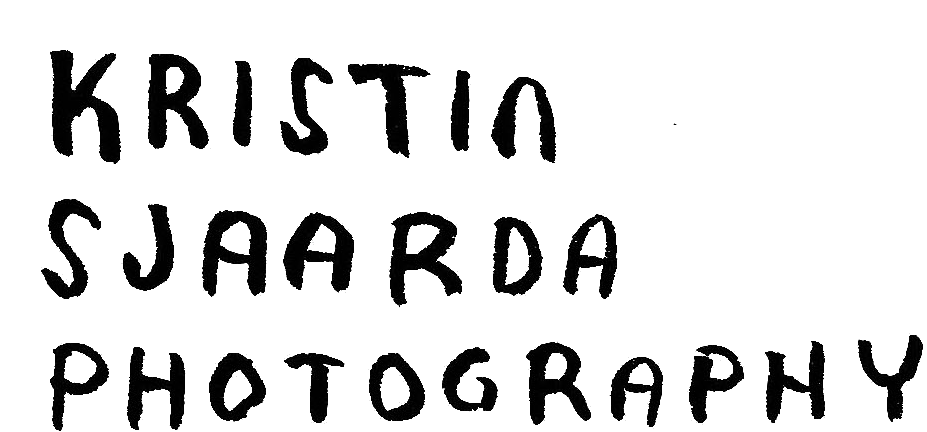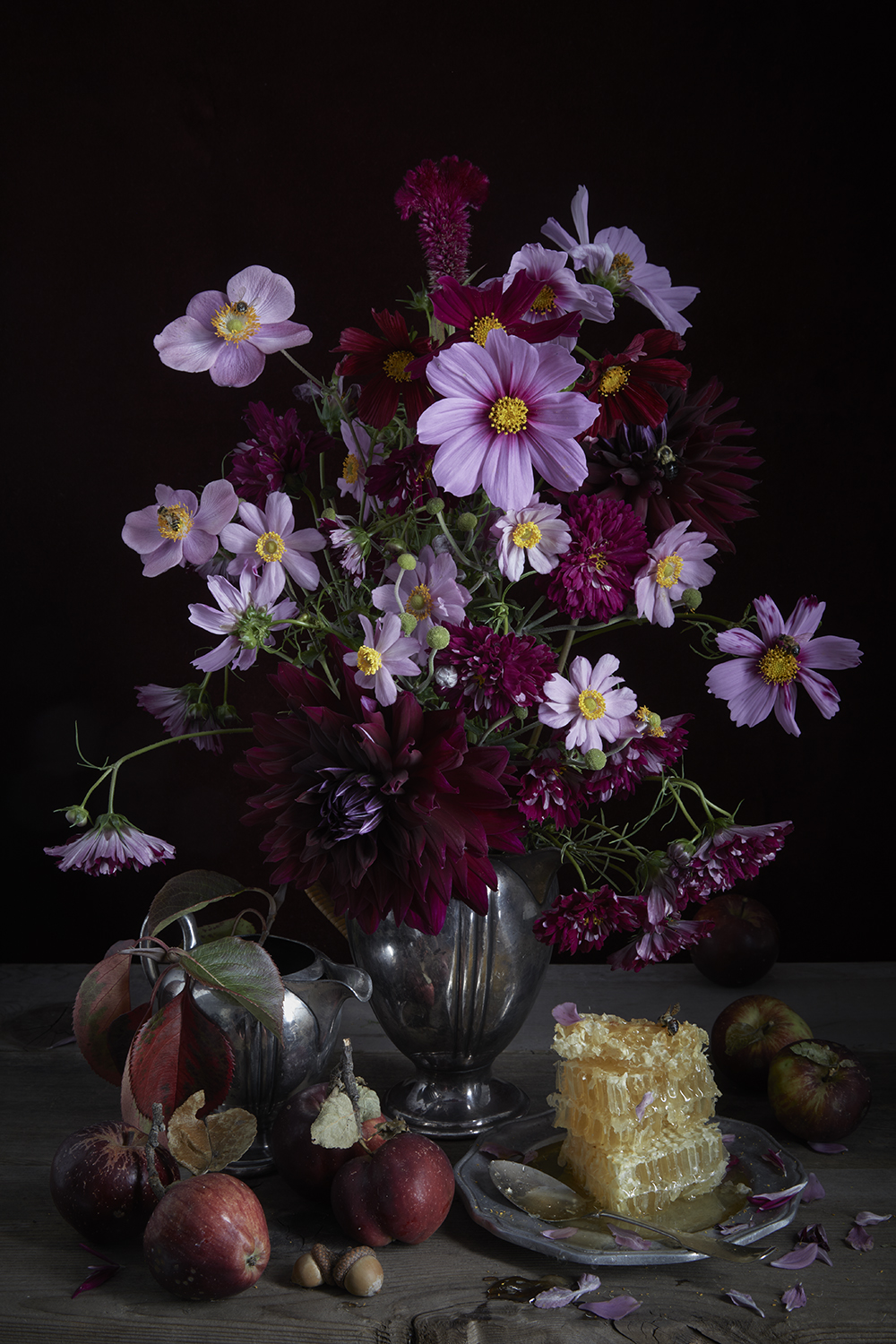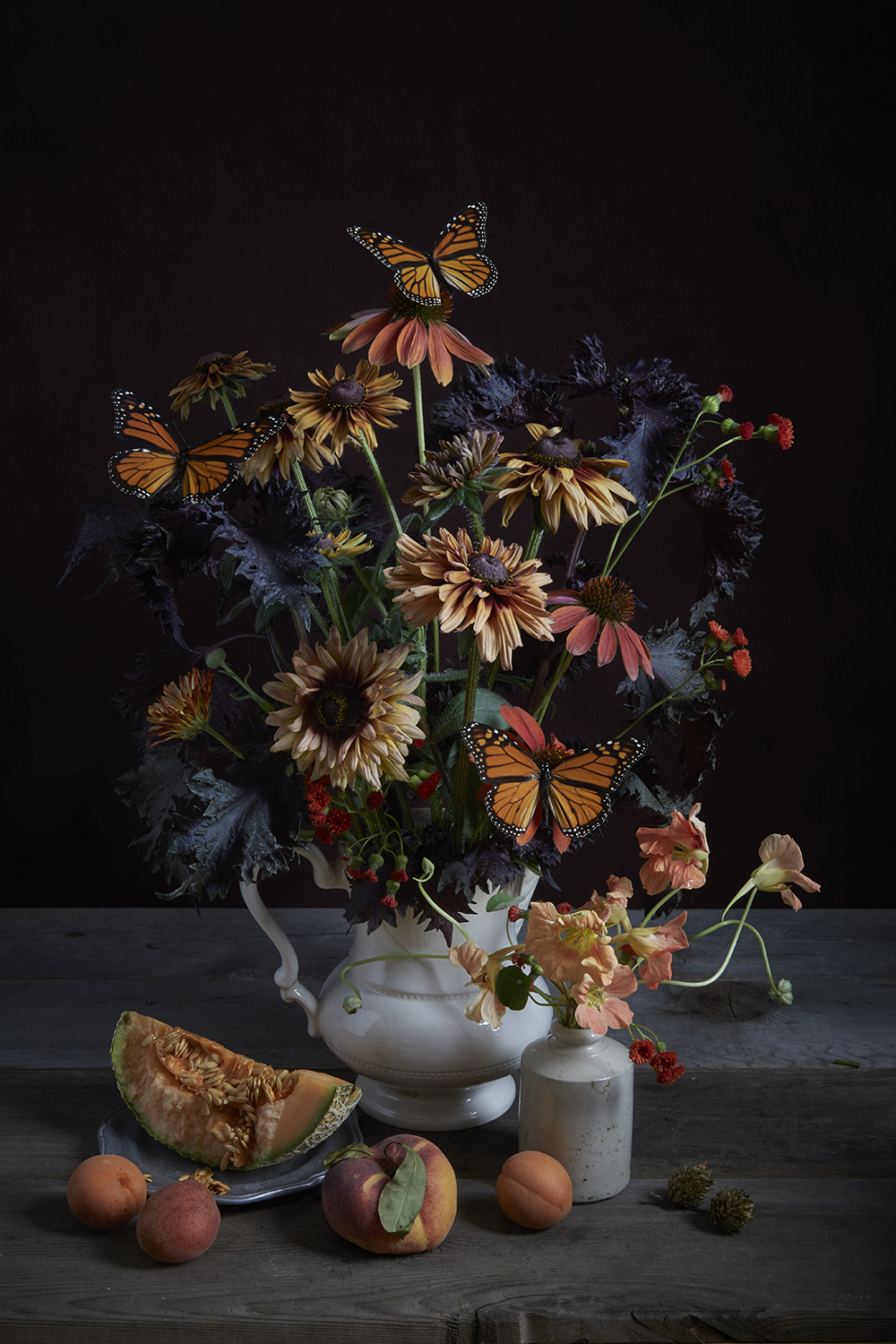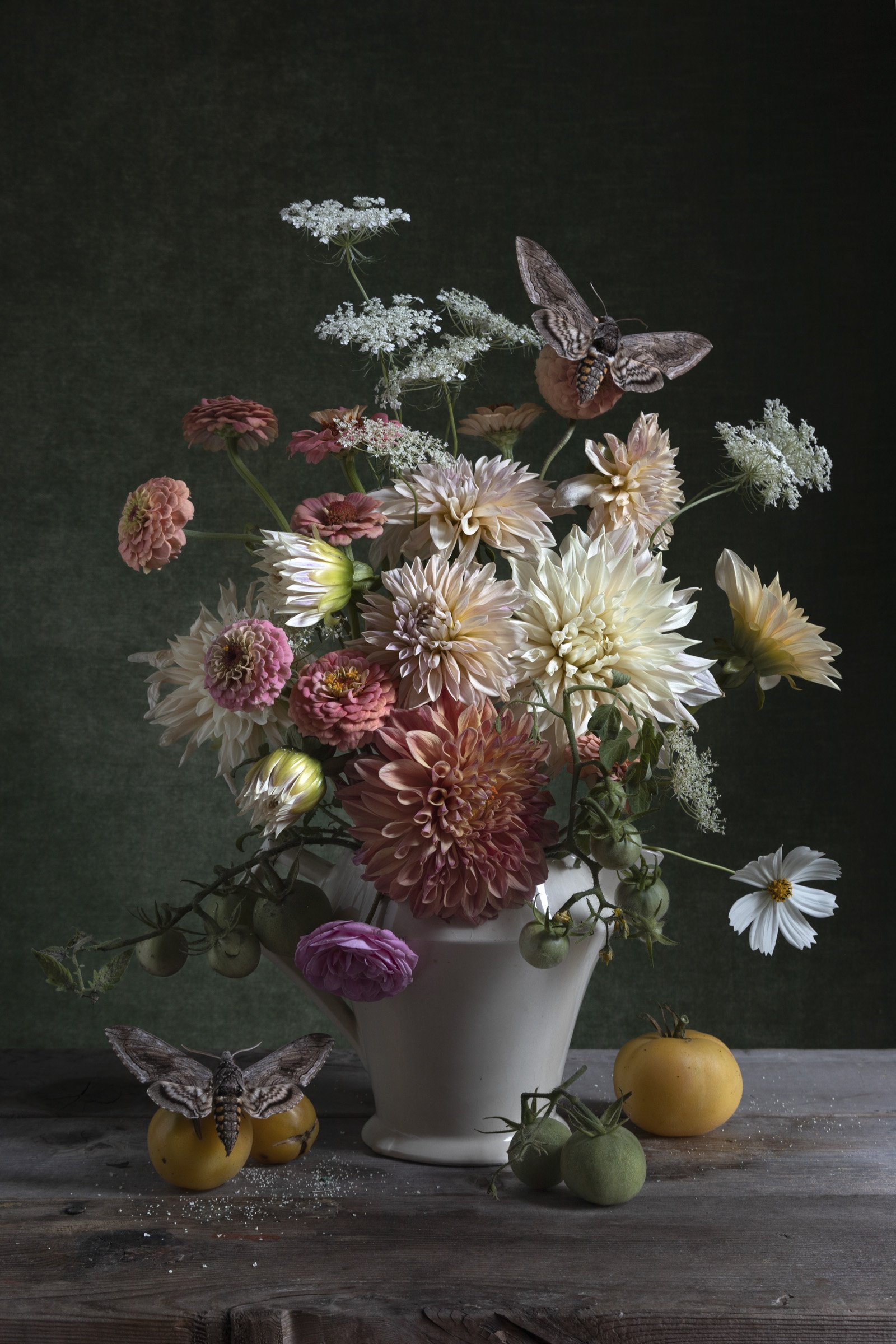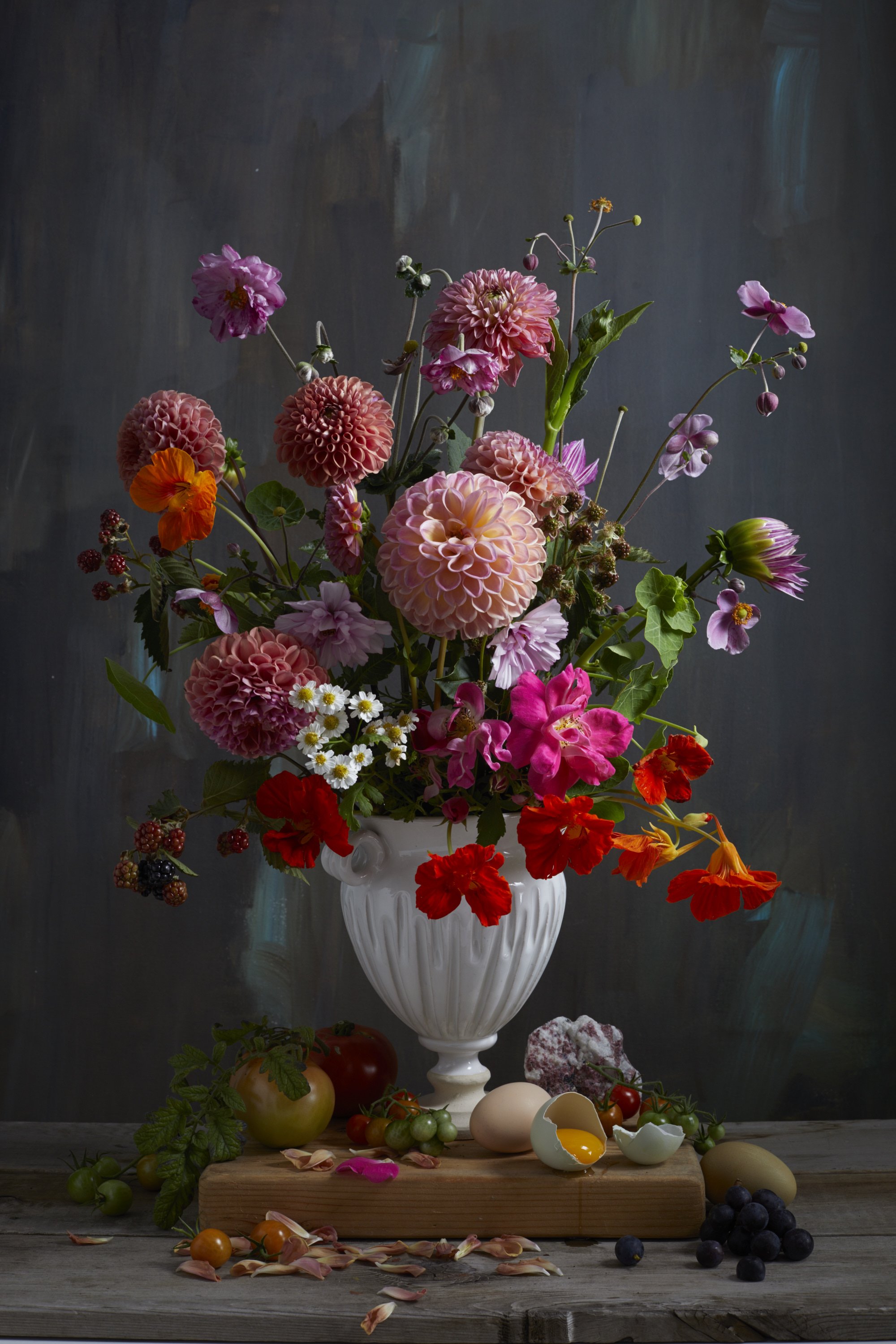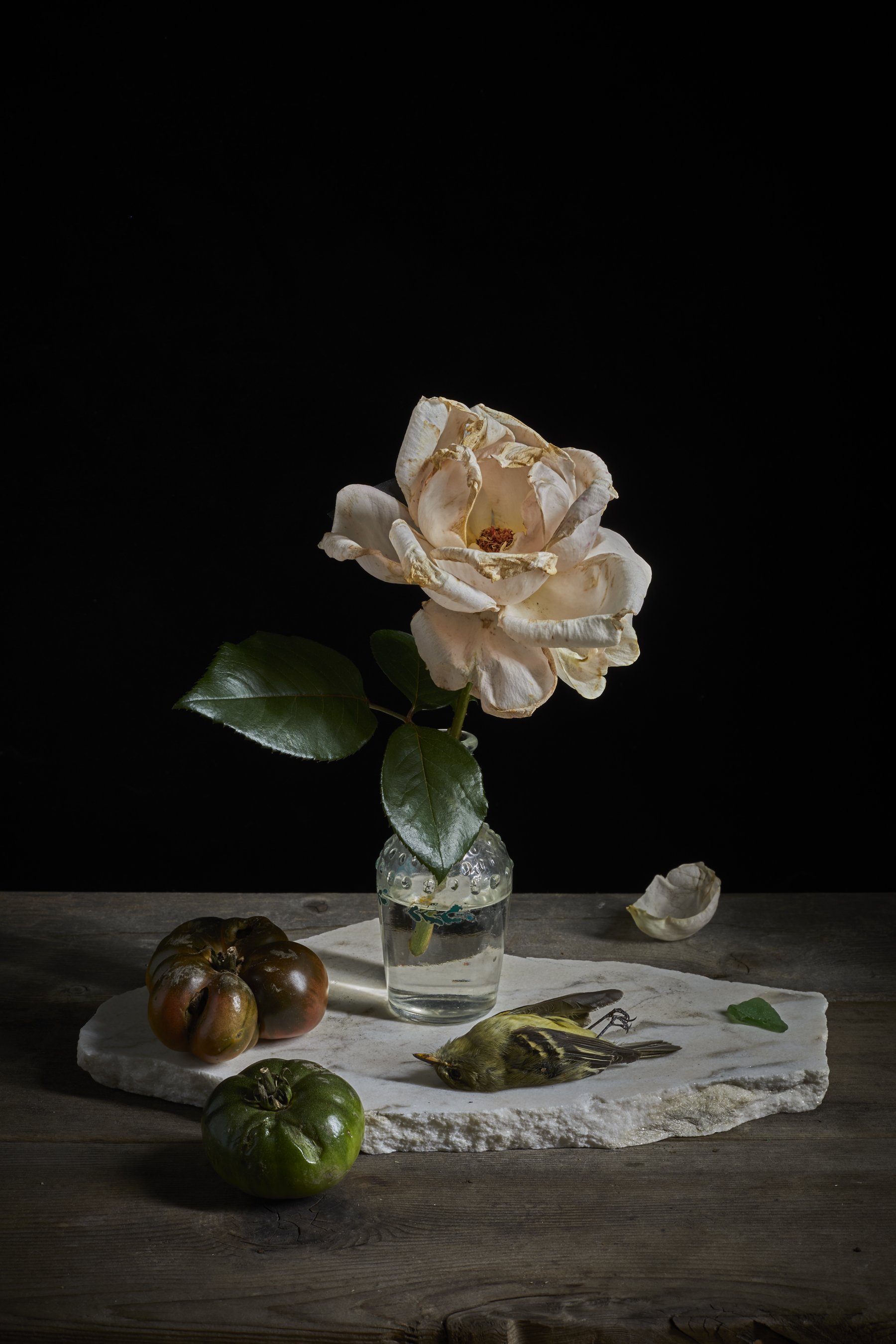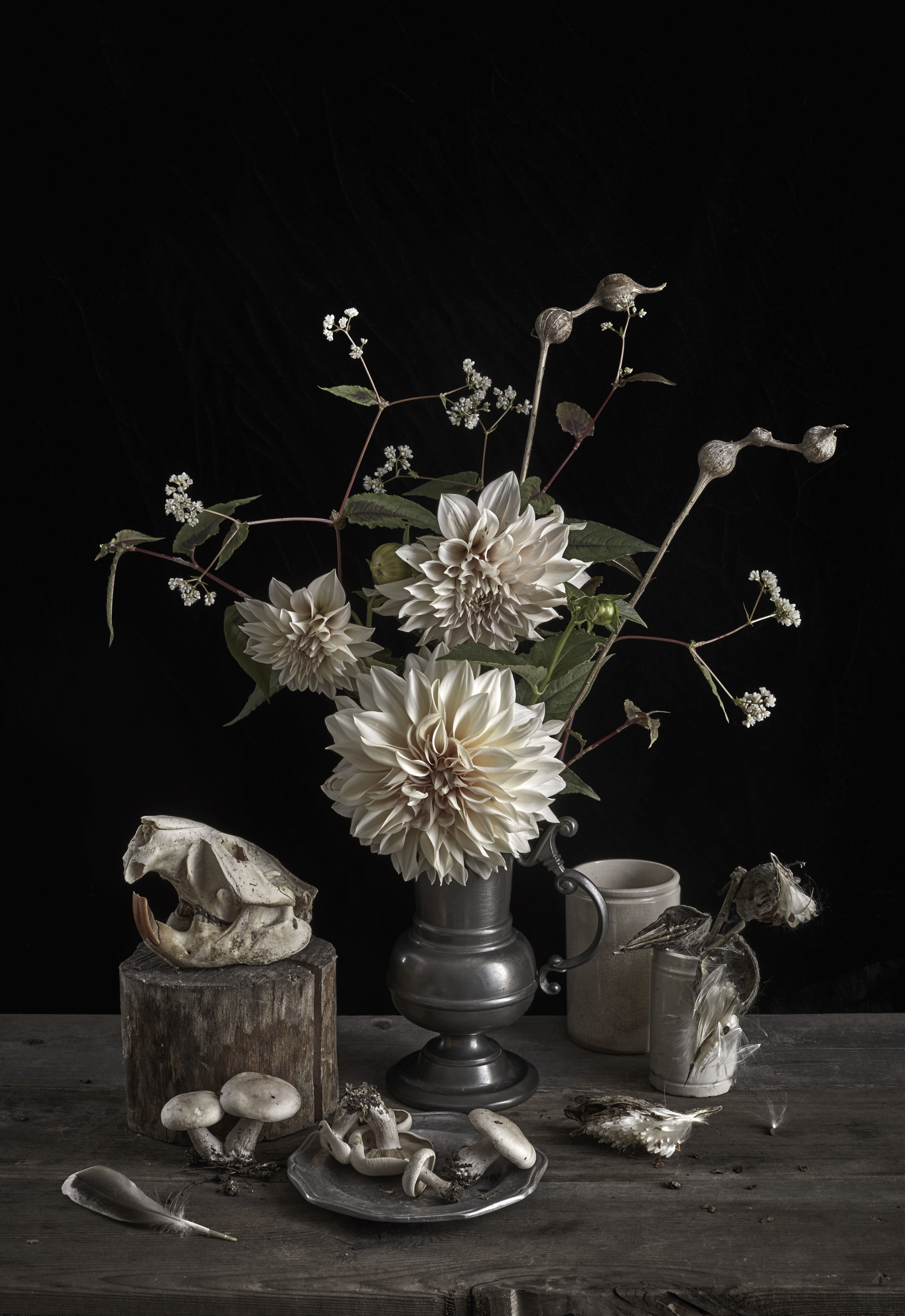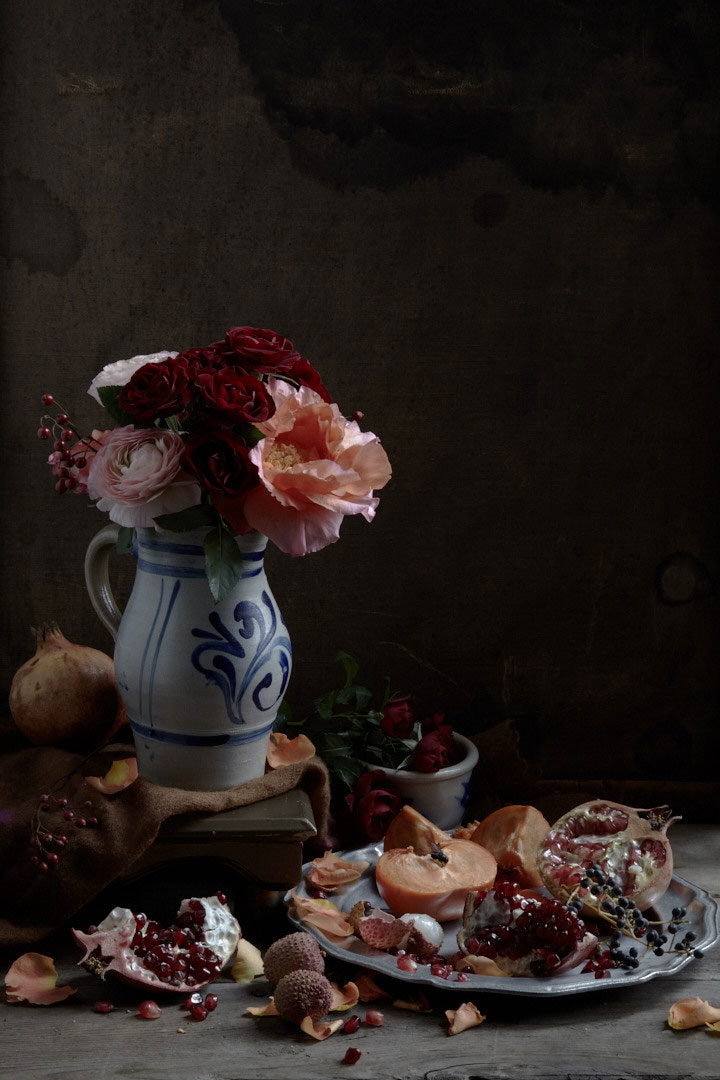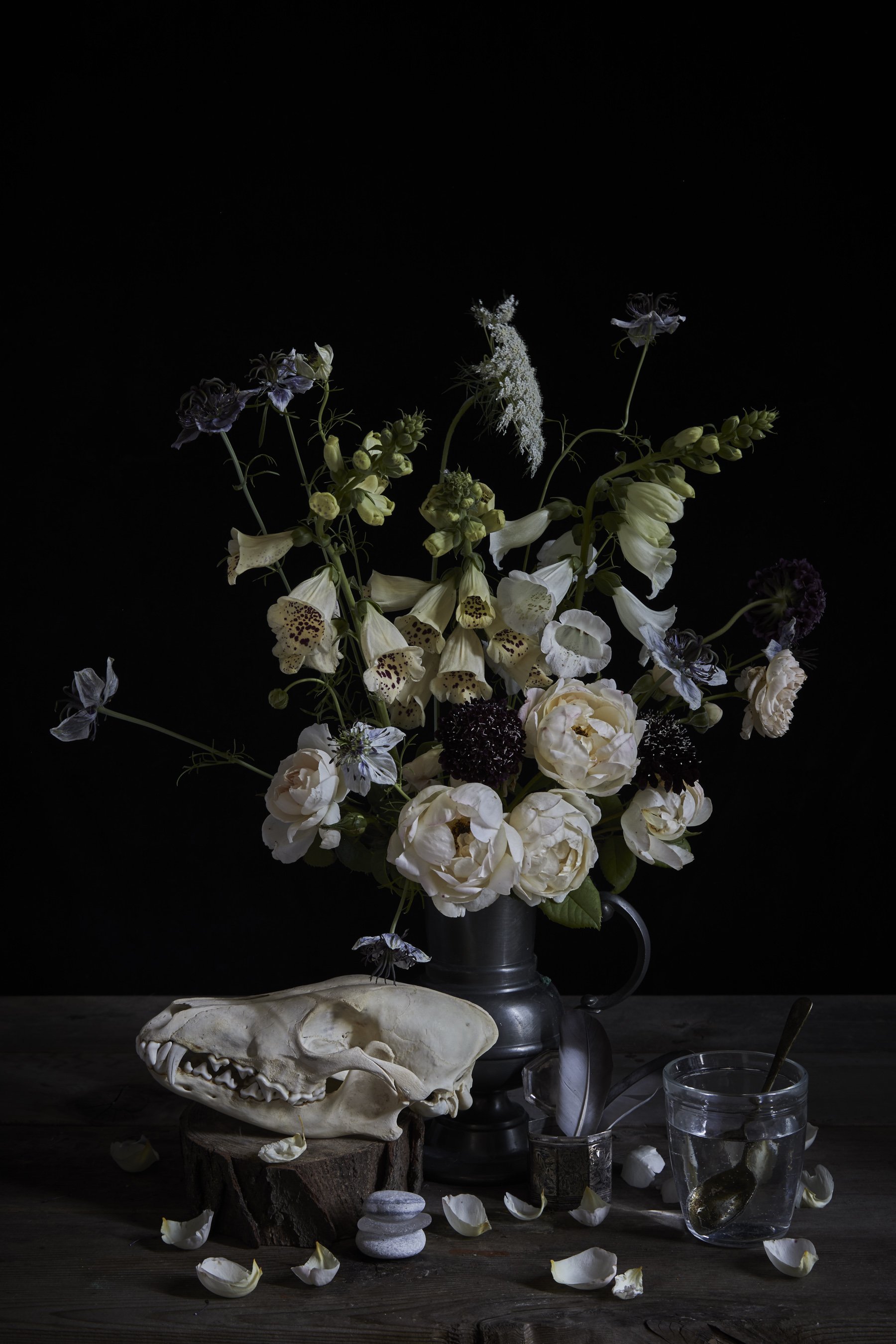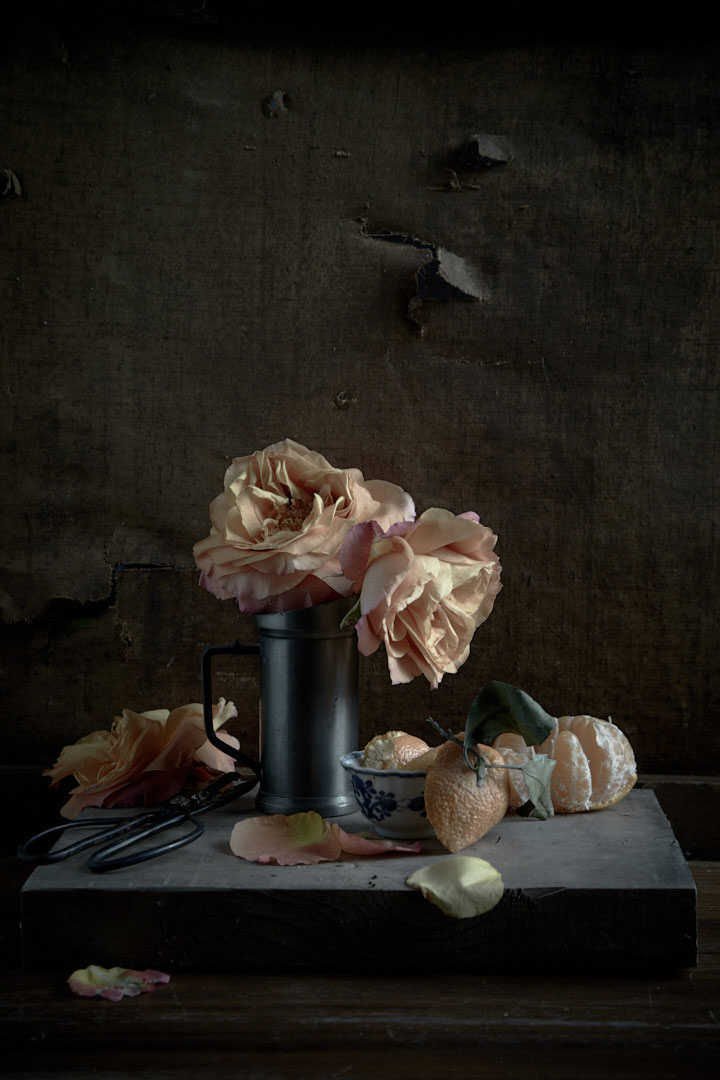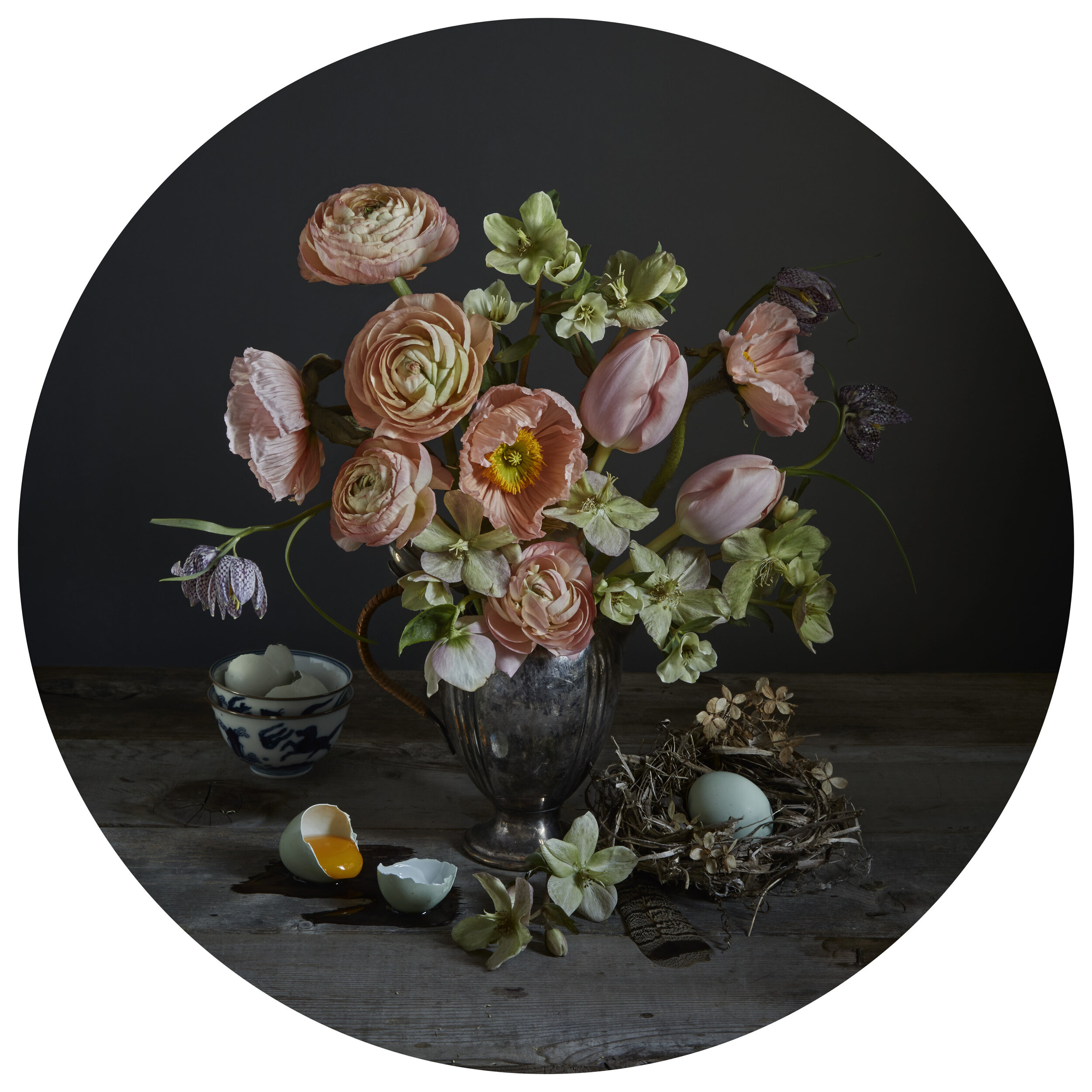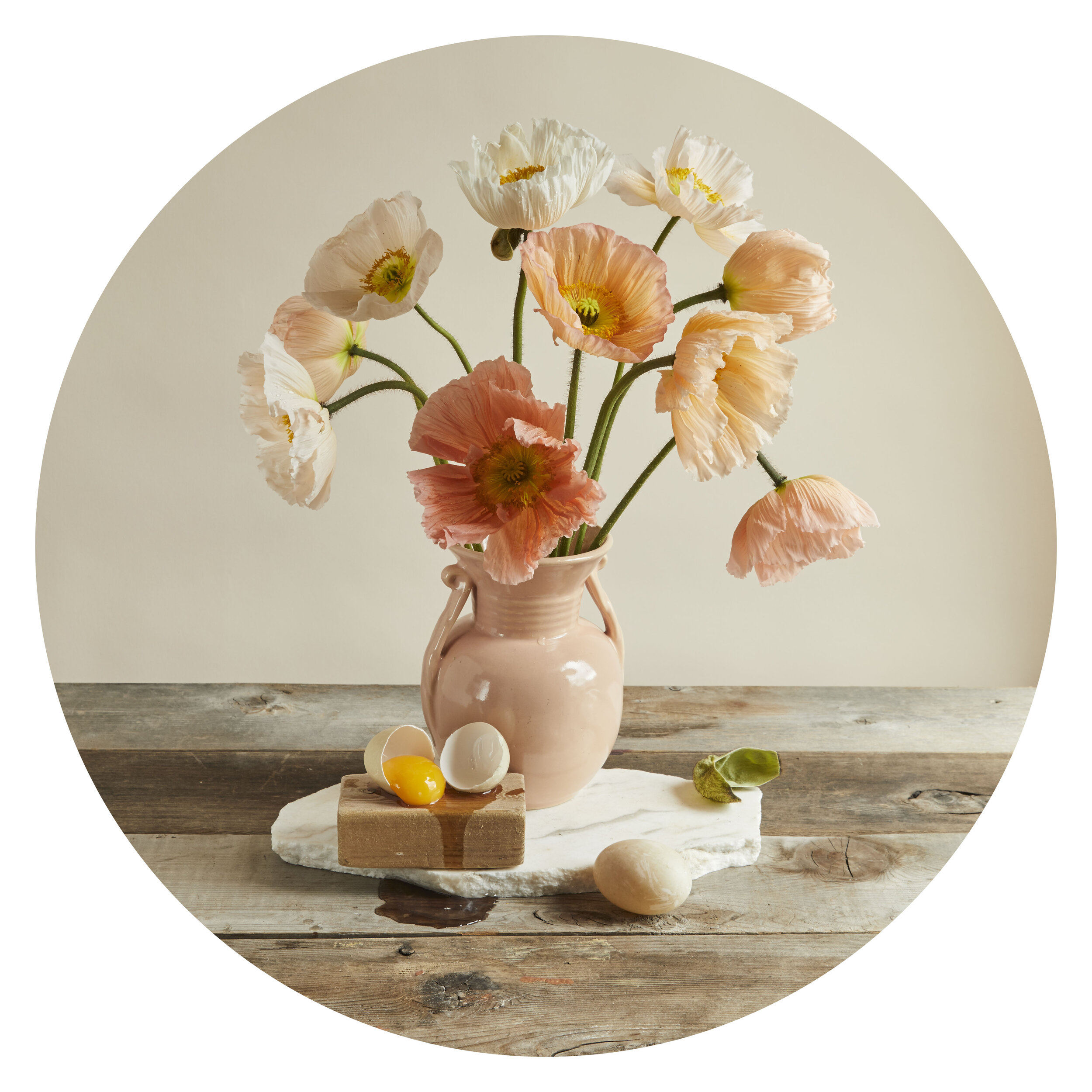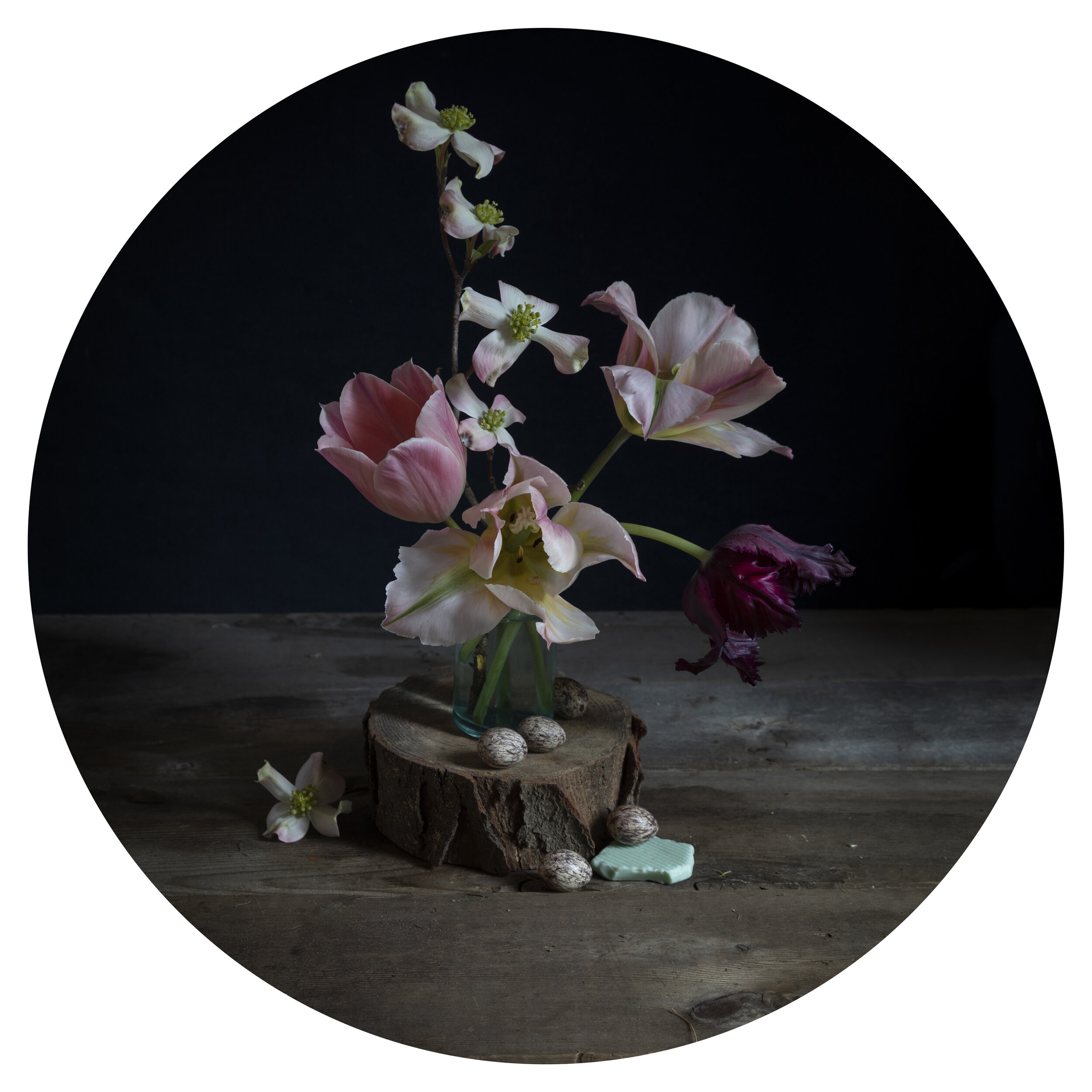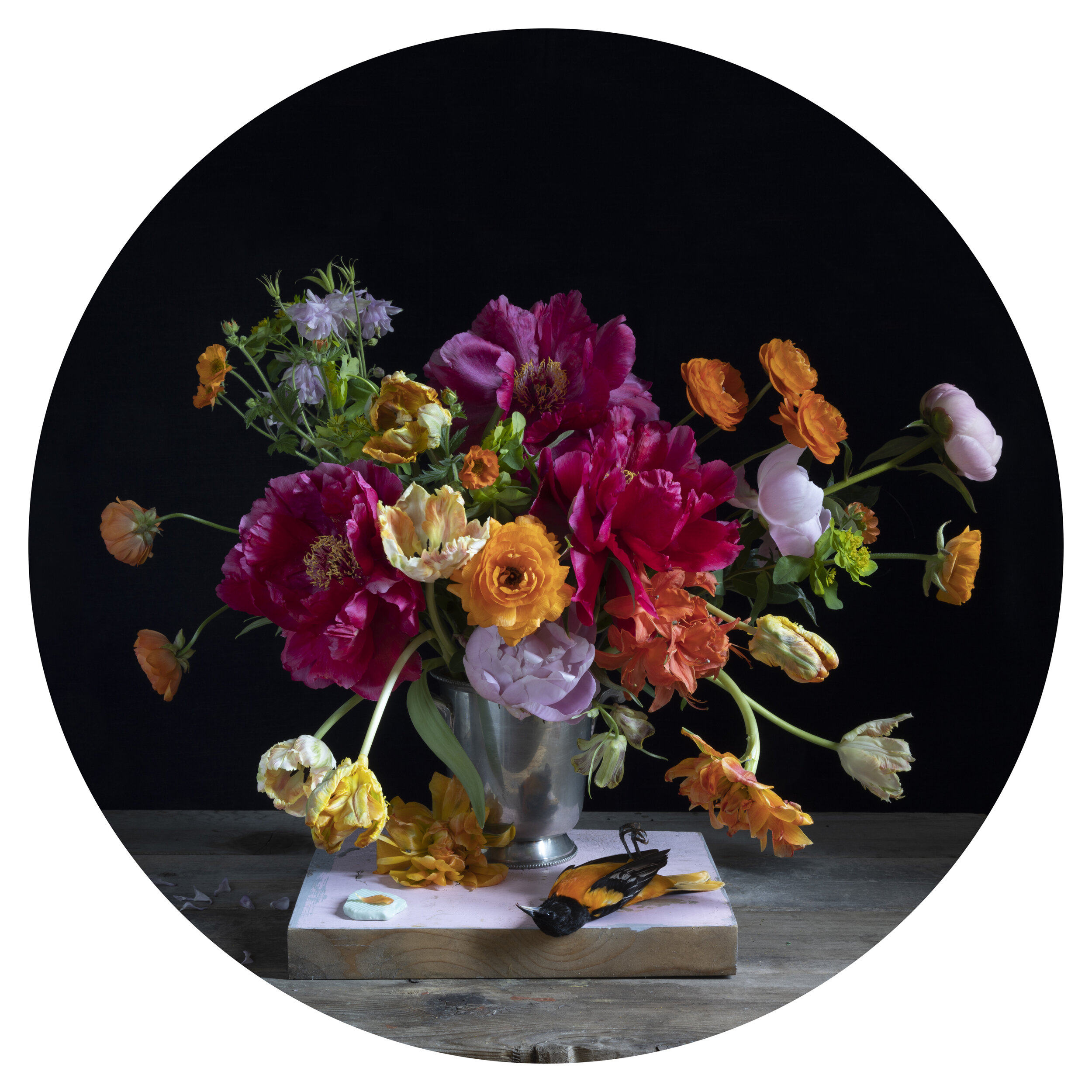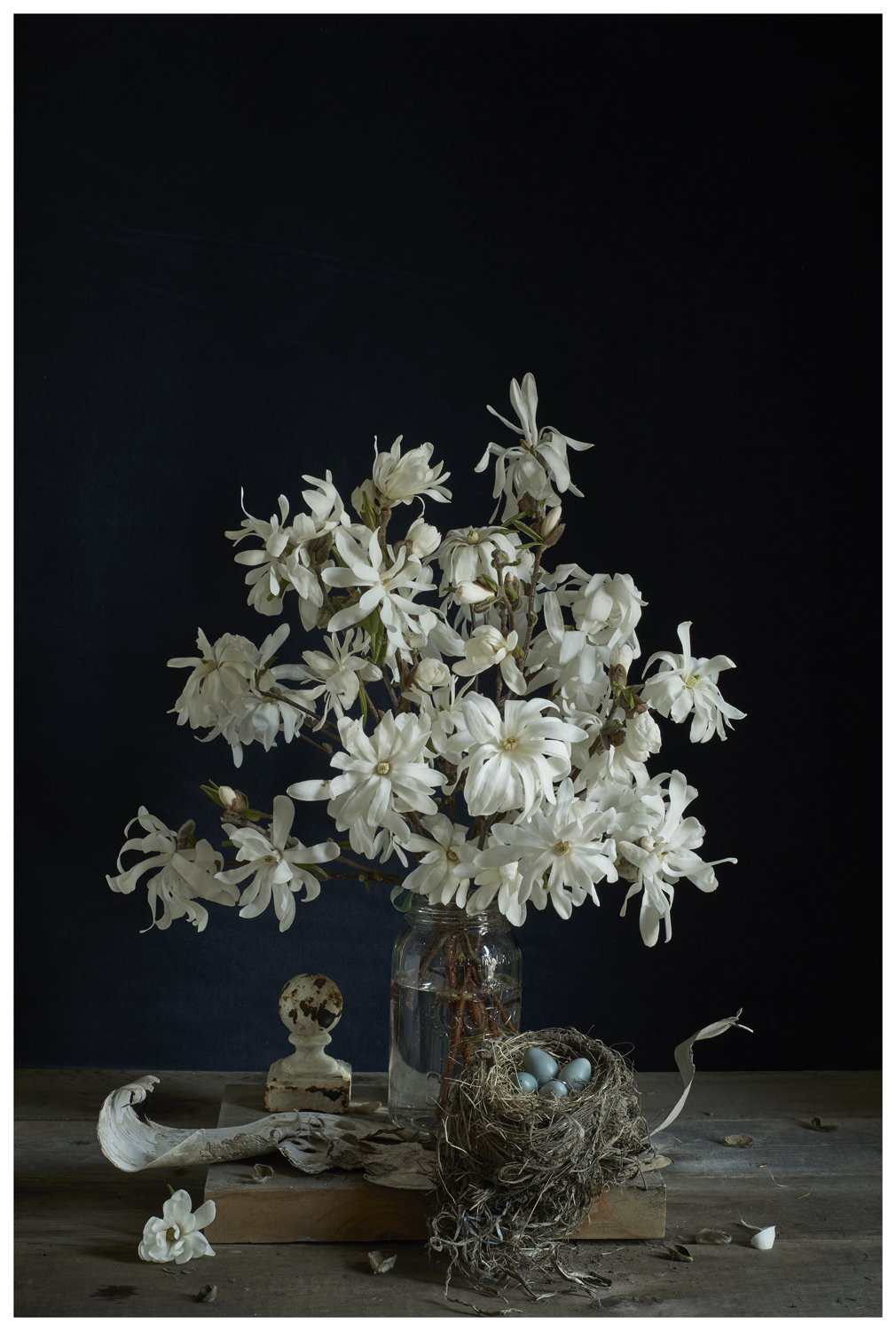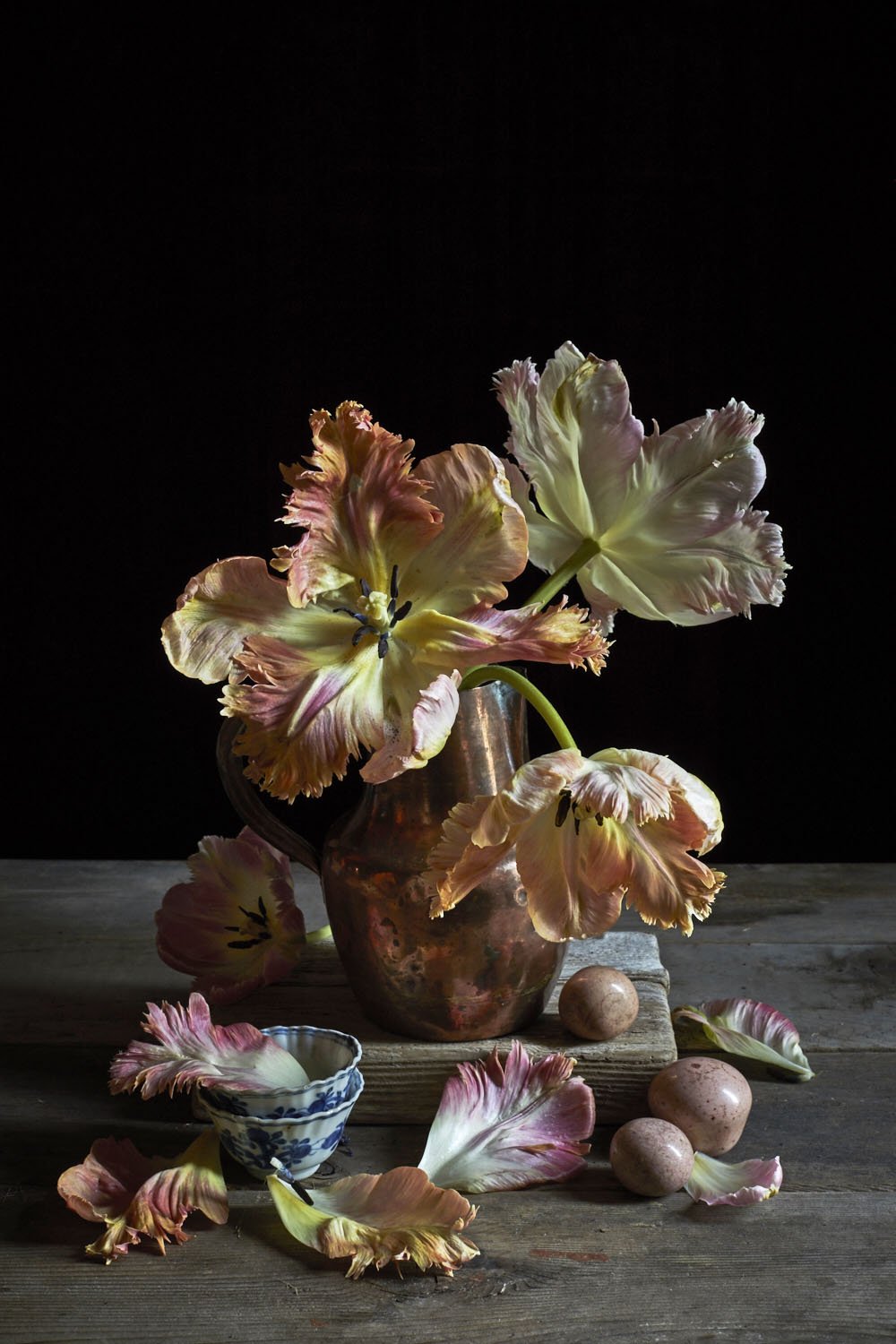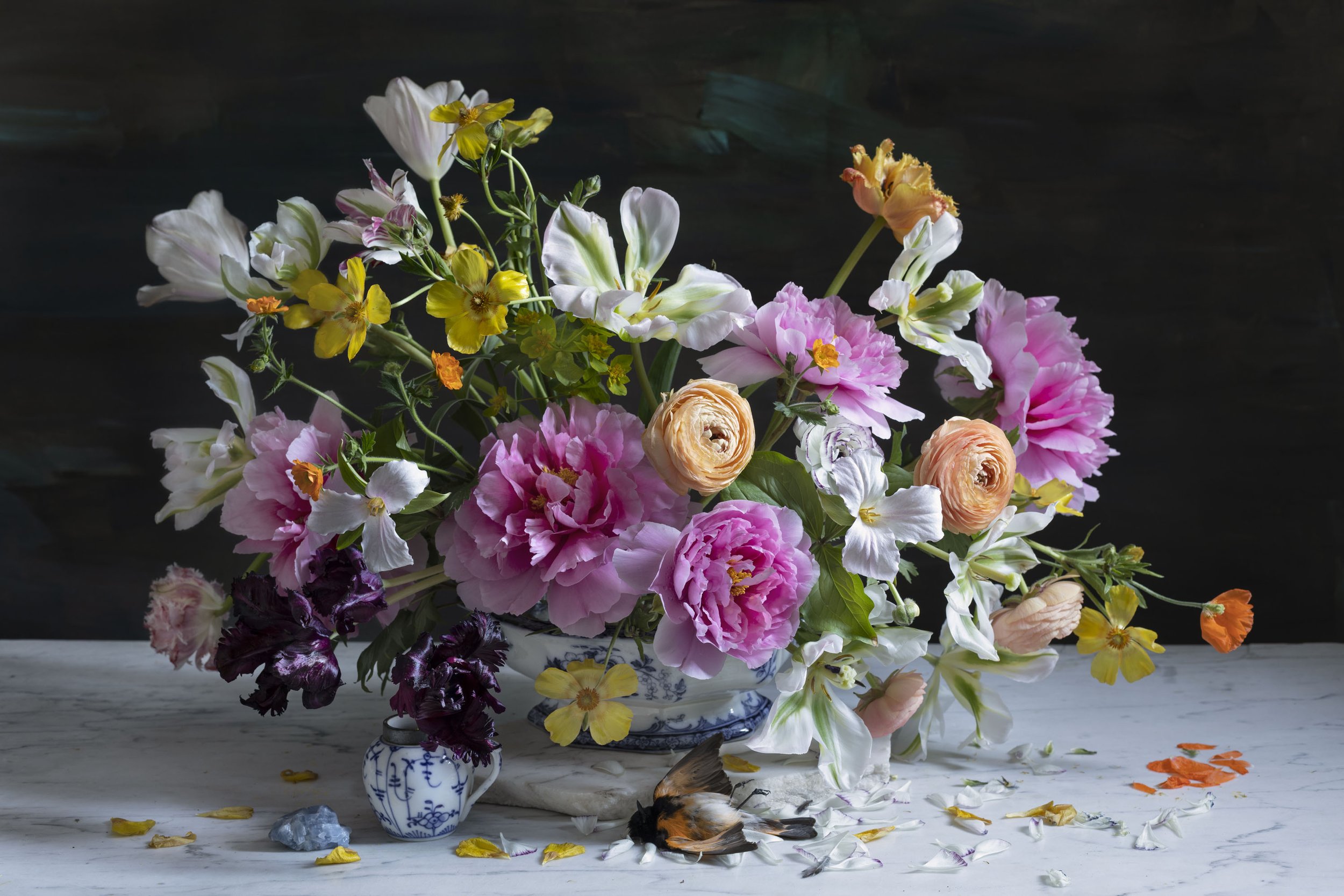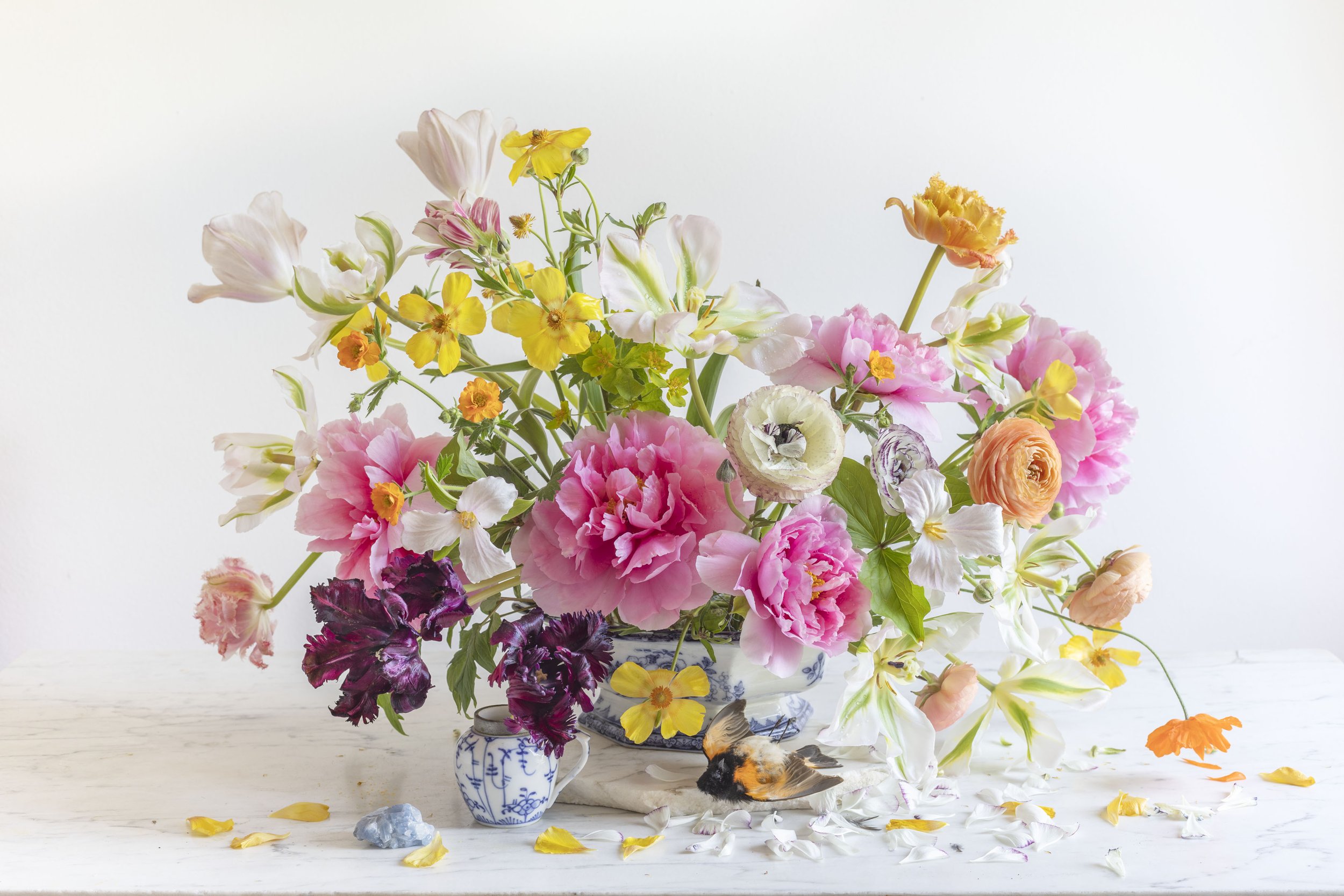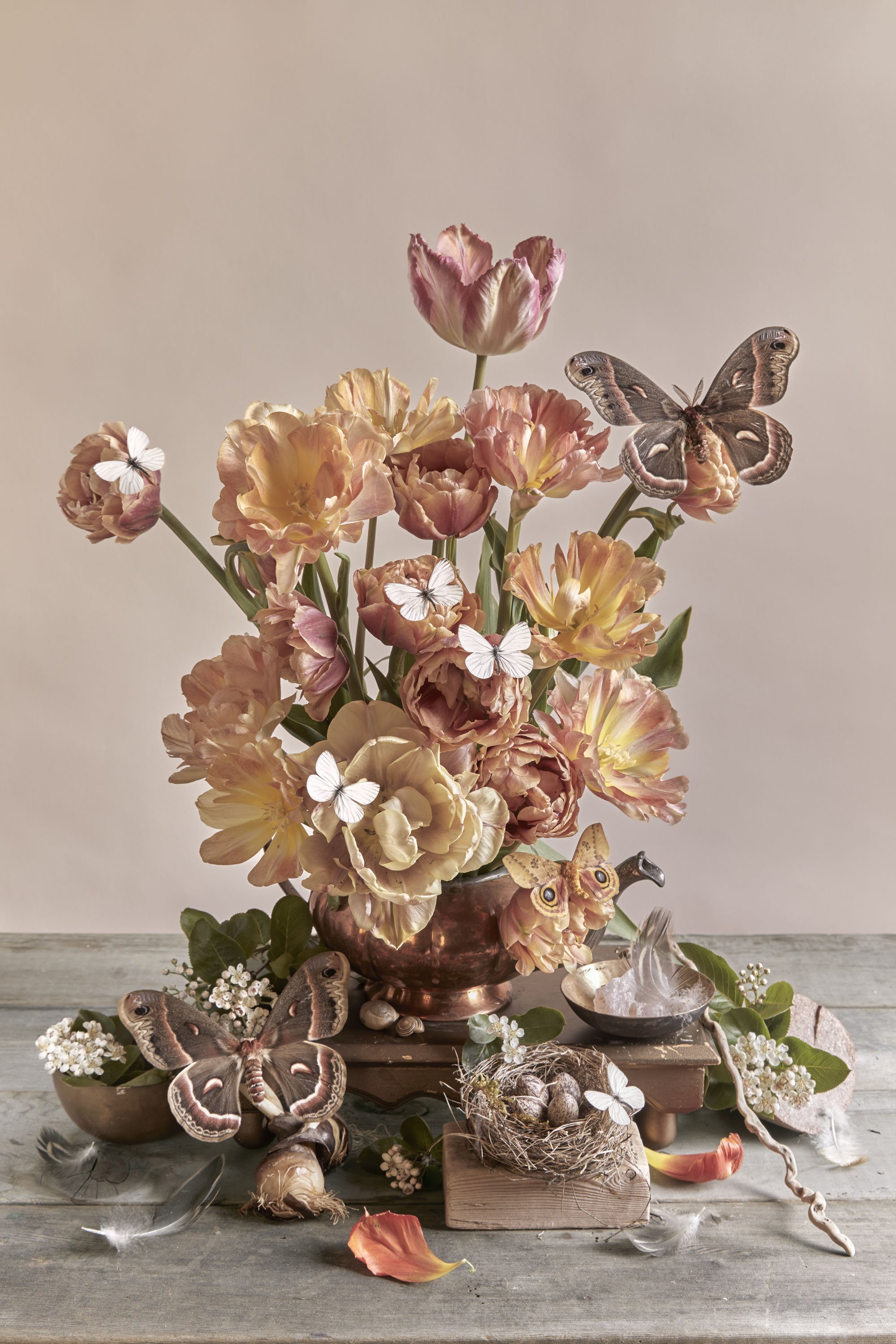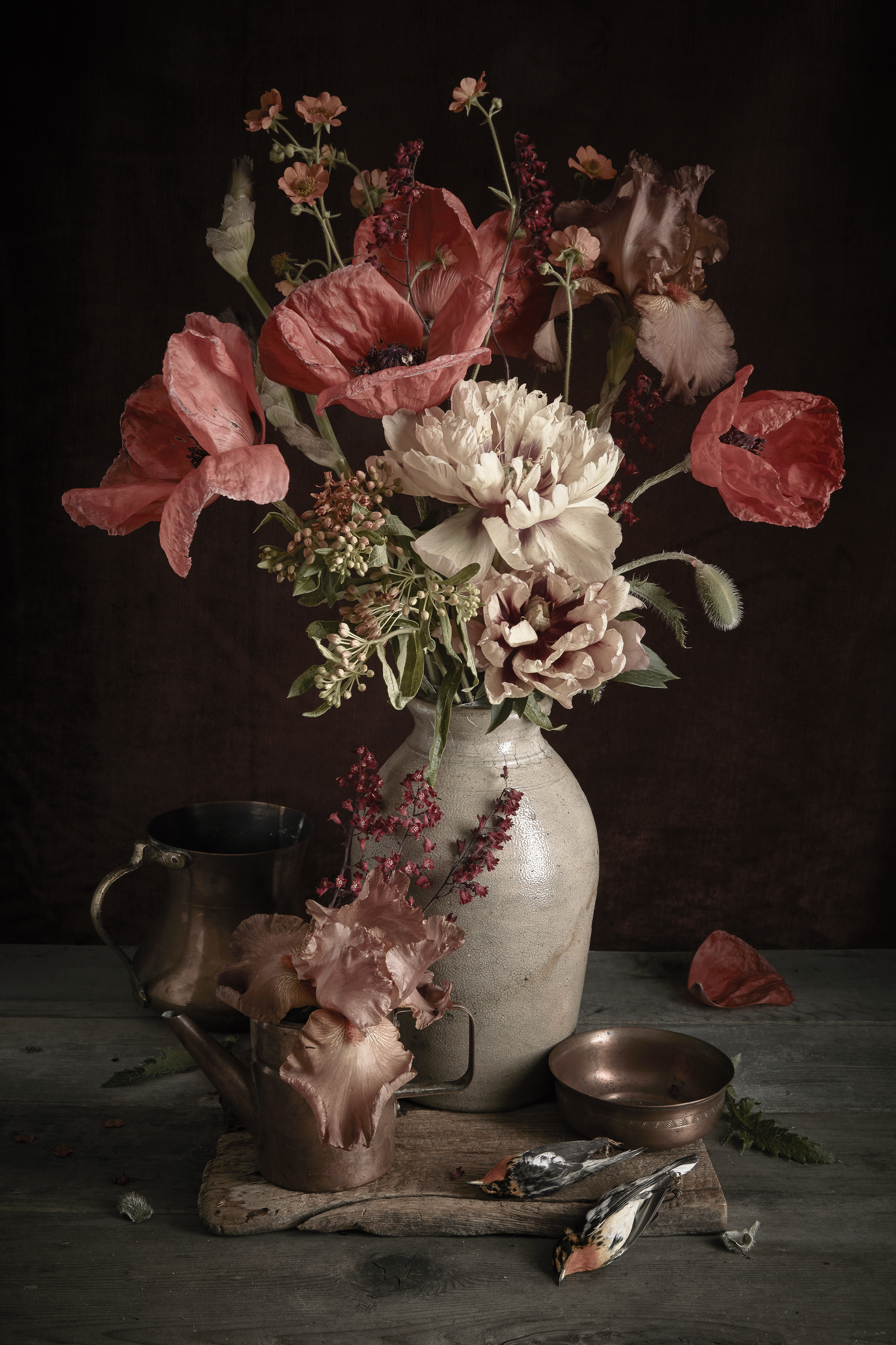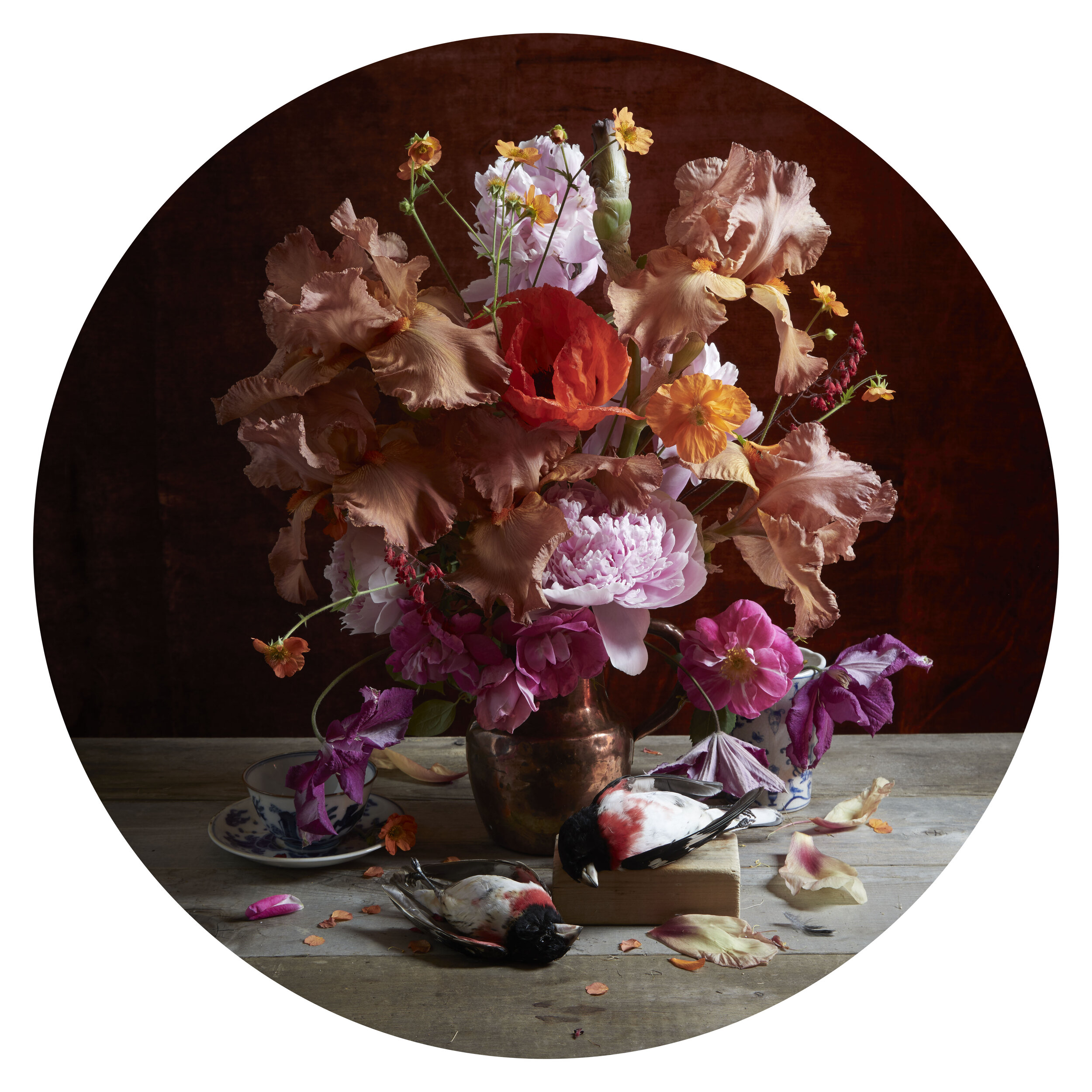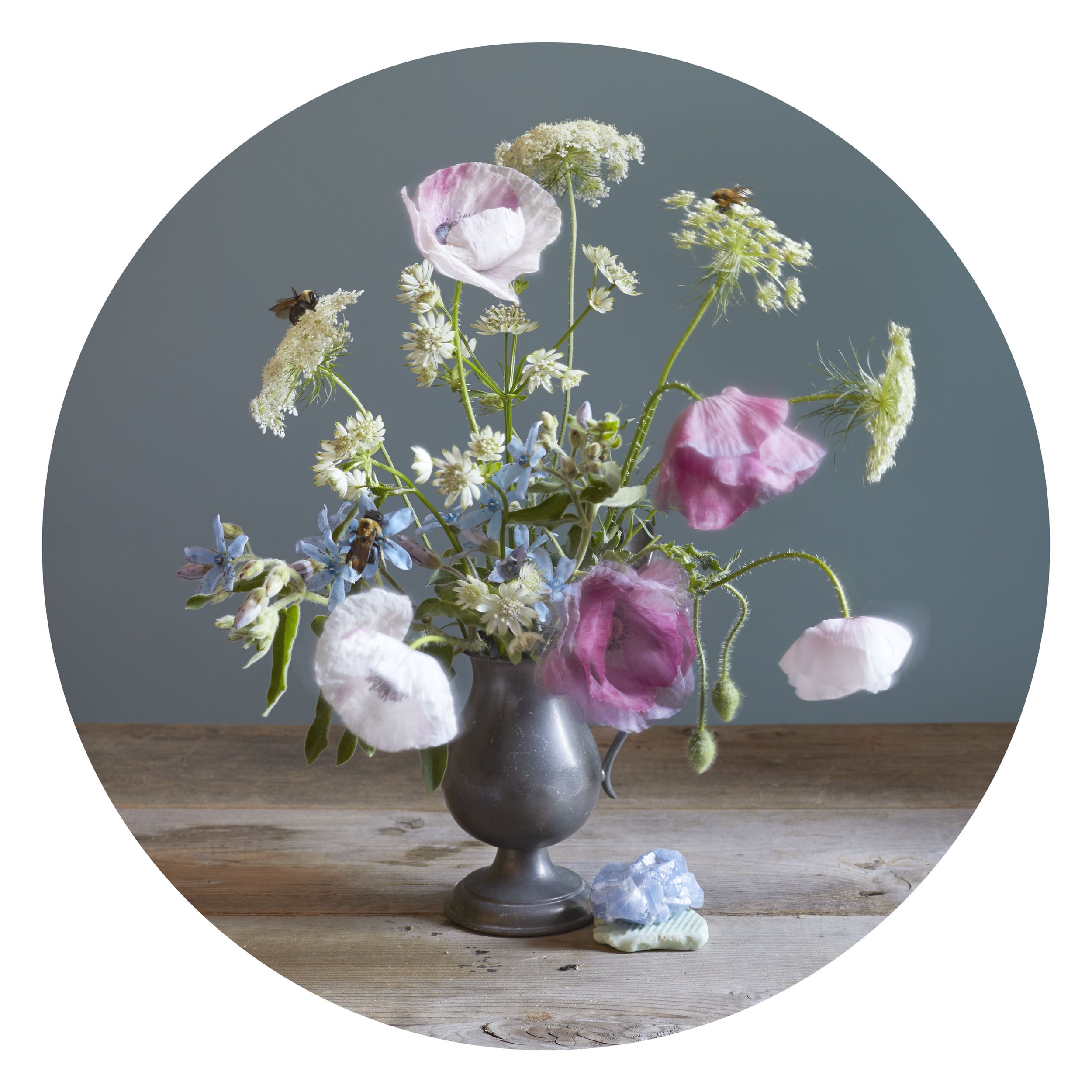autumn
Just when the growing season is coming to a close, there is a burst of energy. This is the month of Dahlias, Anemone, Cosmos, and all the fruits and vegetables in the garden ripen and are ready to harvest. Fall is a time of collection and preparation. I start by building my studio in my bedroom. I have a table that comes apart when I’m not using it so I assemble the surface first. I work when I get a bucket of flowers from a grower or from my garden. As I only use locally grown flowers I wait until the garden season in Toronto area to make new still life photos. In anticipation of a certain flower coming into bloom I will begin to collect the insects or skulls or vessels to arrange around the flowers. Sometimes I only have a days notice, and that’s when I work! I place the many jars of flowers around me and start arranging in the vase on my table. As the still life grows, I add in insects, skulls, mushrooms or fruit. Detail on the shadow side of the arrangement, the side opposed to the window, is carefully considered and arranged so that light still defines the details there. I have to work quickly as each of the elements changes as time passes until the arrangement is completely decayed.
winter
In the garden, there is no more growth. The snow blankets the ground. But that does not mean there is nothing happening there. Winter is a time of hibernation and renewal. This is the time the garden and all the animals rest. The idea of composting is a useful image for me. When you look into a compost pile in the winter, it just looks like garbage. but what is happening is a slow process of breaking down the previous years material into essential dirt for the next year. I find this happens for me as well at a creative level. There is no new art being produced but it’s a time for connection, learning, research, contemplation and planning. I go look at paintings. I study how the painters depict light hitting an object, shiny or textured, natural or manmade. And then I look into the shadows to see what colours are there, how a painter renders darkness that is not completely black. Whenever I travel or go to the AGO here in Toronto I find the still life paintings and stand in front of them noting the details until they almost become abstract and separate from the narrative of the painting. When I was in Den Haag recently I sought out a painting of Rachel Ruysch (The Hague, 3 June 1664 – Amsterdam, 12 October 1750) who is especially inspiring to me, particularly her Sotoboscco paintings. She was an avid botanist and studied plants closely. Her paintings often feature the bug bitten leaves, the slugs and snails that turn plant detritus into compost. She painted the most luminous flowers but also paid attention in tiny brush strokes to the forest floor where the fallen petals land and become dirt.
spring
Spring is delightful. This is the time of year when our anticipation is rewarded; we wait all winter for a hint of colour and then suddenly, after a good rain, there is an abundance of flowers in the garden and a flurry of activity as the birds build nests. This collection represents that time of growth, colour and birth. One of the most asked questions that i get about my photos goes something like this; “I can tell you care greatly about creatures and am wondering how you decided to include them in your stilllife. Also, where did you find the (dead) birds?” I do care about creatures. Maybe I get that from my retired veterinarian dad. All of the birds were found in downtown Toronto by volunteers who work with FLAP Canada. Every morning these volunteer go around the tall office buildings and find migrating birds that have collided with the windows. Injured birds are rehabilitated and released north of Toronto. Dead birds are collected and turned over to The Royal Ontario Museum for safe keepng and storage. The ornithologist, Mark Peck, makes these birds available to scientists and artists. I am so honored to be able to give these little avain beauties a “second life” in my photographs. But why would I do that? A few reasons: My still life photos are “portraits of a time and place” with flora and fauna included. Secondly, the birds remind us of how short and precious life is in the tradition of the Momento Mori paintings. and lastly: I am in awe of their tiny, perfect gorgeous feathers and incredible variety. Every spring that I receive new birds I learn about a species I’d never heard of Every fall when I return them to the ROM I’m sad to see them go.
summer
What is endlessly fascinating to me, what draws me back again and again to photograph flowers, is the light. I love the way the light from my home studio window illuminates the petals of the flowers in the arrangement. But I also admire the places where the light doesn’t reach, those mysterious corners where darkness lurks. The vase life of a flower is limited, I work against time and the failing light of the day in order to capture the exact moment when a flower passes its optimum point of beauty to fade into falling apart. Both the setting sun and the dying flowers compel me to work quickly and in the moment. This petal luminosity and beauty is a hook I use to draw viewers in closer to look at these large-scale photographs. At this range, then, they may notice the less flattering items in the photograph, the shadows, the things with fangs, insects consuming the fallen petals, moths and snails. I am constantly working against time and against the ephemeral quality of my subject matter. Working from home the presence of my 3 children compounds the constraint of time bringing my awareness to how fast they grow up, and how the life of a flower or insect is a metaphor for our own short human life, and the short sweet summer season. Often in the summer photos i include cicadas. These are large bugs that make that peculiar buzzing noise when the days are hot. Using these bugs n the still life arrangements is meant to evoke memories of that hot summer sensation when the days are longest.
